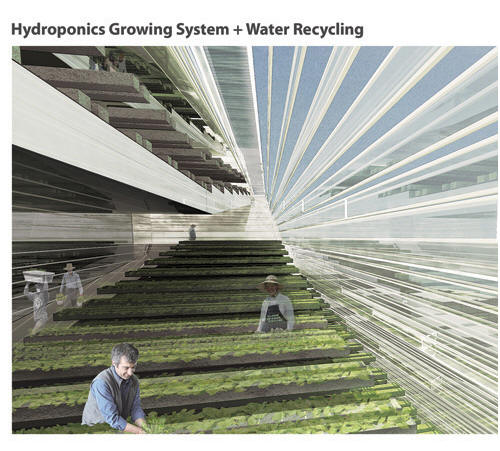June
2010
![]()
AutomatedBuildings.com
[an error occurred while processing this directive]
(Click Message to Learn More)
June
2010 |
[an error occurred while processing this directive] |
|
Building to Grid? What about Building to Farm? |
Ken Sinclair |
If you are having a problems getting your mind around the horizontal reach of building to grid and net zero buildings take a look at this new vertical that put the farm back on top.
|
|
|
|
|
|
|
|
|
|
|
|
|
[an error occurred while processing this directive] |
|
|
|
|
|
|
|
|
|
|
|
|
|
|
|
[an error occurred while processing this directive] |
It took humans 10,000 years to learn how to grow most
of the crops we now take for granted. Along the way, we despoiled most of the
land we worked, often turning verdant, natural ecozones into semi-arid deserts.
Within that same time frame, we evolved into an urban species, in which 60% of
the human population now lives vertically in cities. This means that, for the
majority, we humans are protected against the elements, yet we subject our
food-bearing plants to the rigors of the great outdoors and can do no more than
hope for a good weather year. However, more often than not now, due to a rapidly
changing climate regime, that is not what follows. Massive floods, protracted
droughts, class 4-5 hurricanes, and severe monsoons take their toll each year,
destroying millions of tons of valuable crops. Don't our harvestable plants
deserve the same level of comfort and protection that we now enjoy? The time is
at hand for us to learn how to safely grow our food inside environmentally
controlled multistory buildings within urban centers. If we do not, then in just
another 50 years, the next 3 billion people will surely go hungry, and the world
will become a much more unpleasant place in which to live.
Source http://www.verticalfarm.com/
Advantages of Vertical Farming
[an error occurred while processing this directive]
* Year-round crop production; 1 indoor acre is
equivalent to 4-6 outdoor acres or more, depending upon the crop (e.g.,
strawberries: 1 indoor acre = 30 outdoor acres)
* No weather-related crop failures due to droughts,
floods, pests
* All VF food is grown organically: no herbicides,
pesticides, or fertilizers
* VF virtually eliminates agricultural runoff by
recycling black water
* VF returns farmland to nature, restoring
ecosystem functions and services
* VF greatly reduces the incidence of many
infectious diseases that are acquired at the agricultural interface
* VF converts black and gray water into potable
water by collecting the water of evapotranspiration
* VF adds energy back to the grid via methane
generation from composting non-edible parts of plants and animals
* VF dramatically reduces fossil fuel use (no
tractors, plows, shipping.)
* VF converts abandoned urban properties into food
production centers
* VF creates sustainable environments for urban
centers
* VF creates new employment opportunities
* We cannot go to the moon, Mars, or beyond without
first learning to farm indoors on earth
* VF may prove to be useful for integrating into
refugee camps
* VF offers the promise of measurable economic
improvement for tropical and subtropical LDCs. If this should prove to be the
case, then VF may be a catalyst in helping to reduce or even reverse the
population growth of LDCs as they adopt urban agriculture as a strategy for
sustainable food production.
* VF could reduce the incidence of armed conflict
over natural resources, such as water and land for agriculture

For more insight
http://www.theage.com.au/text/articles/2010/03/15/1268501434892.html
[an error occurred while processing this directive]
[Click Banner To Learn More]
[Home Page] [The Automator] [About] [Subscribe ] [Contact Us]